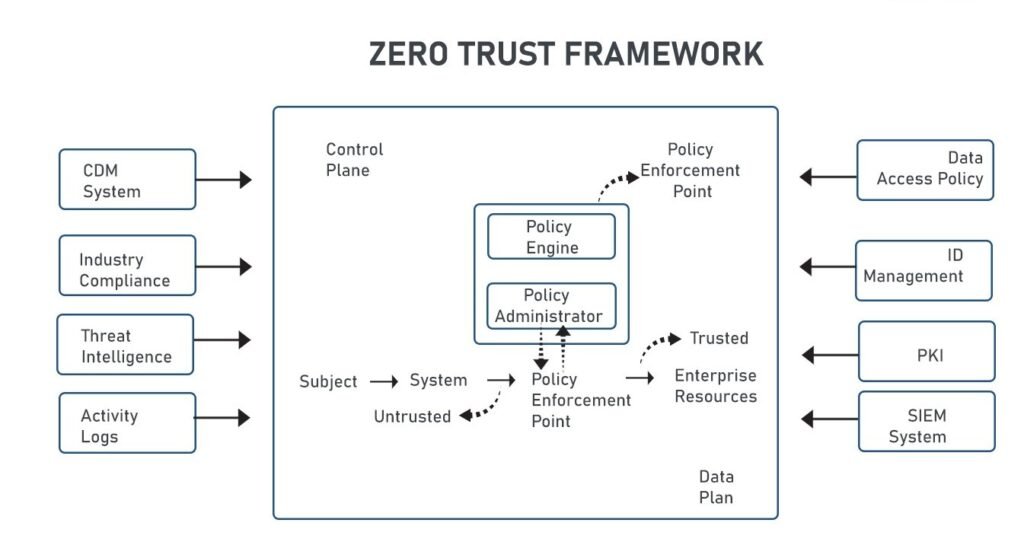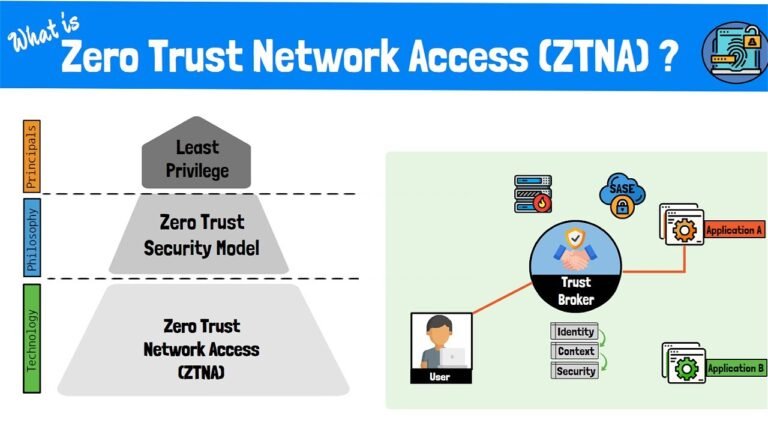Key Takeaways:
- Zero Trust Framework enhances security by continuously verifying user and device identities.
- This model reduces the risk of data breaches by operating on the principle of “never trust, always verify.”
- Zero Trust can help businesses meet regulatory requirements and improve overall security posture.
Table of Contents:
- Introduction
- How Zero Trust Framework Works
- Core Principles of Zero Trust
- Benefits of Adopting Zero Trust
- Challenges and Considerations
- Future Trends in Zero Trust Security
- Conclusion
Introduction
In today’s digital era, businesses face an ever-evolving landscape of cyber threats. Technology’s rapid advancement has brought numerous benefits, but it has also introduced complexities that traditional security models need help managing. These conventional security approaches often rely on perimeter-based defenses, assuming everything inside the network is trustworthy. However, cyber attackers have become increasingly sophisticated, rendering these outdated methods insufficient. This is where the Zero Trust Framework makes its grand entry. A modern approach to cybersecurity, the Zero Trust model operates on the foundational principle of “never trust, always verify.” By continuously validating the identity of users and devices, the Zero Trust framework aims to enhance security and drastically reduce the risk of data breaches, ensuring that business operations are protected from both internal and external threats.
How Zero Trust Framework Works
The Zero Trust Framework operates on the fundamental principle that threats can originate inside and outside the network. It strategically shifts from the perimeter-based security model to a more rigorous approach where every user and device, without exception, must be authenticate, authorize, and continuously validated before being granted access to applications and data. Rather than assuming Trust, this model demands that every access request is meticulously vetted. By enforcing strict access controls and continuously monitoring user activity, Zero Trust minimizes potential entry points for attackers, enhancing overall security. Continuous monitoring ensures that any unusual behavior or unauthorized access attempts are immediately flagged and address.

Core Principles of Zero Trust
Zero Trust Framework is ground in several fundamental principles design to provide robust security. These principles are not standalone but work harmoniously to create an impermeable layer of defense:
- Verify Explicitly: This principle emphasizes the need for rigorous and continuous authentication and authorization processes. Whether a user is inside or outside the network, their identity must be verified explicitly using multi-factor authentication and context-based access assessments. This means verifying who the user is and assessing factors such as their location, device, and typical behavior patterns.
- Use Least Privilege Access: Users should be granted the minimum level of access necessary to perform their tasks. This principle minimizes the potential damage if an account is compromise. By strictly limiting access permissions, organizations ensure that even if malicious actors gain access, their capacity to inflict harm is significantly curtailed.
- Assume Breach: The Zero Trust model operates under the assumption that breaches are inevitable. Continuous monitoring of suspicious activity is fundamental. By assuming that breaches can and will occur, organizations remain vigilant, constantly looking for any signs of unauthorized access or anomalies in user behavior, enabling them to respond swiftly and prevent significant damage.
Benefits of Adopting Zero Trust
Adopting the Zero Trust Framework offers a range of benefits that can significantly enhance an organization’s security posture. By eliminating the assumption of Trust within the network, organizations are better prepare to defend against increasingly sophisticate cyber threats:
- Enhanced Security: Zero Trust reduces the likelihood of unauthorized access and data breaches by continuously verifying user and device identities and enforcing strict access controls. This approach provides a more secure working environment by thoroughly vetting every access request.
- Regulatory Compliance: Many industries have stringent security requirements that align with Zero Trust’s principles. Implementing this framework can help businesses meet regulatory standards and avoid costly fines. Zero Trust’s continuous monitoring and detailed access logs also facilitate compliance with industry-specific regulations and audits.
- Improved Productivity: With Zero Trust, employees can securely access applications and data anywhere, promoting flexibility and productivity. Working remotely without compromising security is particularly beneficial in today’s increasingly mobile workforce.
- Real-Time Threat Detection: Continuous monitoring allows for real-time detection and response to potential threats, minimizing the impact of security incidents. This proactive approach ensures that any suspicious activity is identifie and dealt with promptly, reducing the risk of significant data breaches.
Challenges and Considerations
While the Zero Trust Framework offers significant advantages, its implementation can present several challenges and considerations. Understanding these challenges can help organizations prepare and navigate the transition more effectively:
- Technical Complexity: Transitioning to Zero Trust requires a thorough overhaul of existing security infrastructure, which can be technically complex and resource-intensive. Organizations must ensure that their network architecture and security tools are compatible with Zero Trust principles, which may involve significant investments in new technologies and system upgrades.
- Employee Resistance: Staff members accustomed to traditional security models may resist the changes associated with Zero Trust. Effective communication and training are essential to overcoming this resistance, ensuring that employees understand the benefits of the new approach and how it will enhance their security and productivity.
- Cost Implications: Implementing Zero Trust may require significant investments in new technologies and staff training. However, the long-term benefits, including reduced data breaches and improved regulatory compliance, often outweigh the initial costs, making it a worthwhile investment for enhancing overall security.
- Continuous Adaptation: Cyber threats constantly evolve, necessitating constant monitoring and regular updates to the Zero Trust strategy. Organizations must remain vigilant and flexible, continuously adapting their security measures to address new and emerging threats effectively.
Future Trends in Zero Trust Security
As technology advances, the Zero Trust Framework will evolve to incorporate innovations. Emerging technologies such as artificial intelligence (AI) and machine learning (ML) are expect to play a significant role in the future of zero-trust security. These technologies can enhance real-time threat detection and response, making the Zero Trust model even more robust. AI and ML can quickly analyze vast amounts of data, identifying patterns and anomalies that may indicate a threat, allowing faster and more accurate responses. Additionally, as organizations increasingly adopt cloud services and remote work becomes more prevalent, the principles of Zero Trust will become even more critical in safeguarding sensitive information and maintaining data integrity. The shift towards hybrid work environments and digital transformation initiatives means businesses must continuously adapt their security measures to protect against vulnerabilities introduced by new technologies and working practices.
Conclusion
Securing your business requires a proactive and comprehensive approach in an era of escalating cyber threats. The Zero Trust Framework offers a powerful solution by continuously verifying user and device identities, enforcing strict access controls, and monitoring for potential threats in real-time. While its implementation may present challenges, the benefits of enhanced security, regulatory compliance, and improved productivity make it a worthwhile investment. By adopting the principles of Zero Trust, organizations can significantly reduce the risk of data breaches and ensure the protection of their critical assets in an increasingly digital world. Embracing Zero Trust is not just about responding to current threats; it’s about building a resilient security posture that can adapt to future challenges, providing long-term protection for your business.

